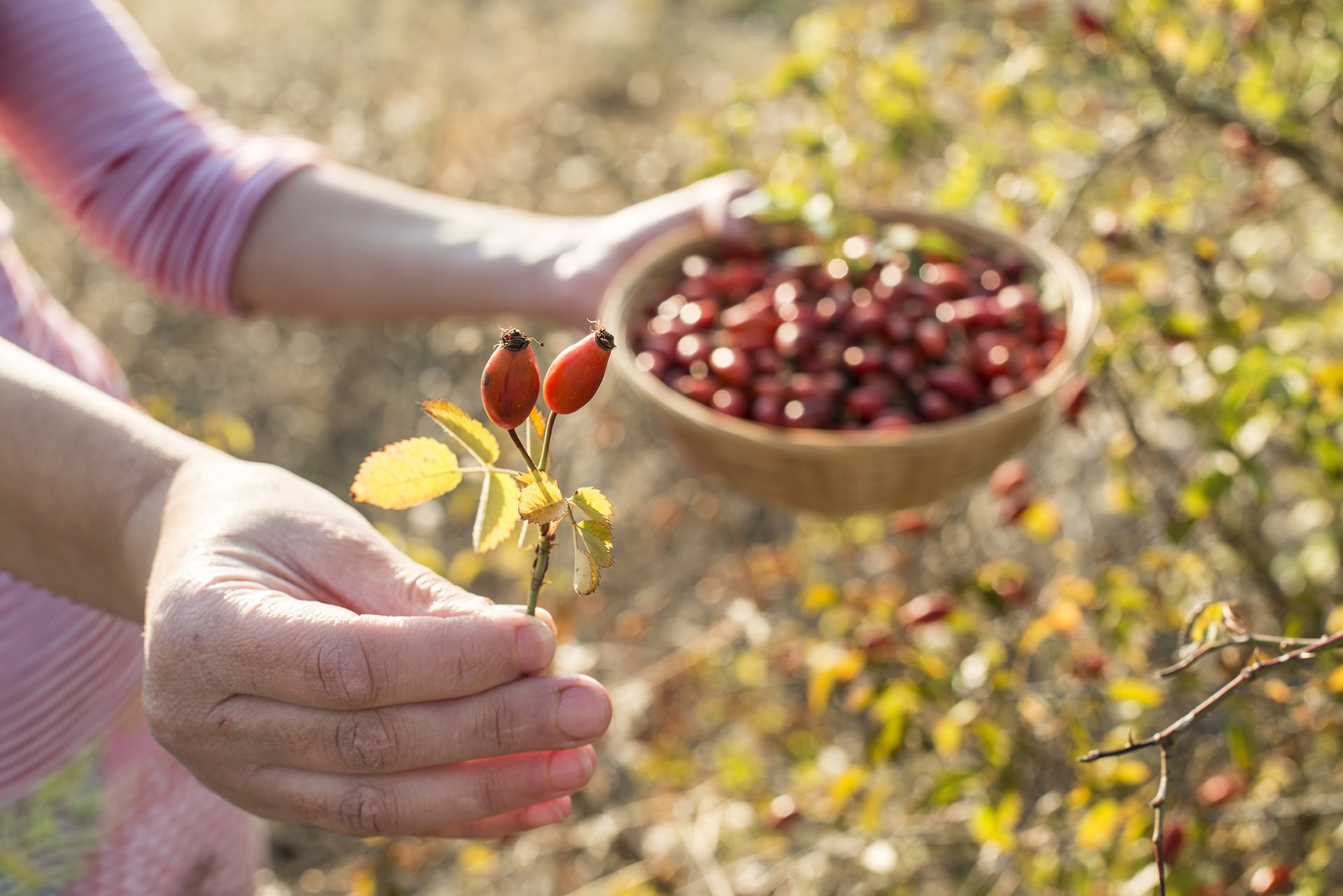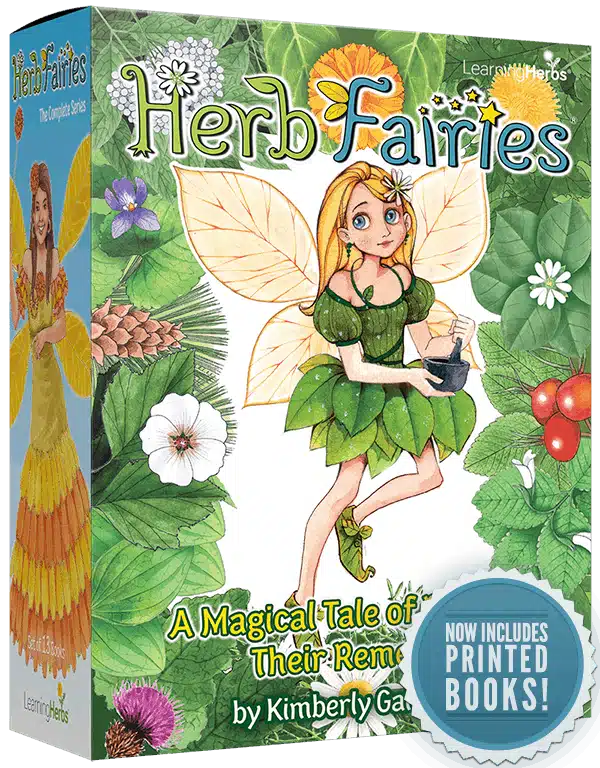“What are the benefits of rosehips?” Well, that’s a great question…
Many of us didn’t grow up knowing about herbal medicine or wild foods.
And I’m sure I don’t need to tell you that learning about them as an adult can be an exhilarating and eye-opening experience.
I remember my own experiences of realizing how many potential healing plants and food existed outside my door. I would basically race from plant to plant wondering, “What does this plant do? What is this plant good for?”
As I’ve continued on this plant path I’ve come to realize that while those are the common beginning questions we tend to ask, they aren’t what we really need to know.
What’s more, if we stay stuck asking those questions we miss out on the wonder-filled, fun, and intricate world of herbal medicine.
The question, “What are the benefits of rosehips?” (or any plant for that matter!) assumes two things that aren’t really accurate. (And this is exactly where a lot of people go wrong in their herbal studies, leaving them frustrated and overwhelmed.)
The first assumption is that the plant in question is exactly the same as all the other plants of its kind out there.
The second assumption is that each person who works with that plant will react the same.
Here’s what I mean by that…
For a moment, imagine all the different apples you’ve eaten in your life. Perhaps some were sweet and crisp as you bit into the raw fruit. Others might have been more sour, puckering up your mouth. Others might have been bland and mealy or soft. Some apple memories conjure up sweet and spiced foods like pie (yum!).
In other words, not all apples (or even apple preparations), are the same.
Some of you may love apples, some of you may not. Some people are even allergic to apples and eating them raw causes their mouth to itch. So just as all apples aren’t the same, how we as humans feel and react to apples is also not the same.
So instead of asking, “What are the benefits of XYZ plant?” or even “What is this plant good for?” it’s more revealing (and accurate) to develop your herbal toolkit to uncover the unique qualities of plants (and people).
Developing Your Herbal Senses
Thinking back to those apples… the reason we know not all apples are the same isn’t because we read about it, or even because someone told us. Instead we know apples because of our senses.
We can see that apples come in a variety of shapes and sizes.
We can taste that apples have a variety of flavors and textures (from sweet and sour to crisp and soft).
And we can experience how apples feel to us when we eat them. (And how the many apple preparations make us feel — from apples paired with cheese to apple juice to apple pie.)
The ability to use your senses to discern an herb’s unique flavors and qualities is one of the best skills you can learn as an herbalist.
With this developed special ability herbs come to life!
It’s like having a magical wand that gives you insight into plants and how they heal.
With this skill you can…
- Determine whether an herb (or herbal preparation) is potent or weak.
- If a particular year’s harvest is better for one ailment or another.
- If similar plants can be used interchangeably.
- How to know the best substitute of one herb for another.
- And so much more!
From Apples to Rosehips…
So, what are the benefits of rosehips? Well, just like apples, rosehips aren’t all the same!
Rosehips are healing herbal medicines. Fresh rosehips are filled with vitamin C and other bioflavonoids. Dried rosehips have less vitamin C but still have many gifts, including the ability to modulate inflammation. This is especially beneficial for your heart health and for decreasing arthritic pain.
When taken daily in food-like amounts (40 grams per day), rose hip powder has been shown to improve blood pressure and plasma cholesterol, thus reducing cardiovascular risk factors.1
With their bioflavonoids and other antioxidants, roses are wonderful for modulating inflammation. This can be especially helpful when there is pain associated with inflammation.
For example, studies have shown that regular ingestion of rose hips can decrease the pain and inflammation associated with both osteoarthritis and rheumatoid arthritis.2,3
Like all herbs, rosehips vary widely according to where they grow, when they were picked, how they were prepared and on and on.
Some rosehips are sweet and plump. Others are hard and bitter. Many times rosehips have a bit of sourness.
All those different tastes and textures tell us that each rosehip we encounter is unique, and, as a result, has unique gifts and qualities.
How to Identify and Harvest Rosehips
There are many different species of wild and cultivated roses in North America, each with their own characteristic rose growing pattern. What follows is a general description of wild roses. Your own local species may vary.
Wild roses typically grow as a shrub in dense thickets, which may reach three meters in height and be many more meters in width. Roses reproduce both by seed and by sending out suckers from the roots.
All wild rose flowers have five petals and numerous stamens. The flowers are commonly a shade of pink or less commonly white. Cultivated roses come in many different colors and typically have many petals.
The deciduous leaves are oddly pinnately-compound with a varying number of leaflets, the most common being three or five or seven leaflets. The leaves grow alternately up the stem.
Wild roses have varying numbers of thorns, what botanists call prickles, which grow along the stem and sometimes along the leaf ribs.
A pollinated flower will slowly develop into a green fruit (rose hips!) that gradually turns to yellow, orange, or red when ripe.
Inside the fleshy fruit are many seeds covered in tiny hairs. The seeds are not edible and need to be removed before eating. If the seeds are not removed, as in some rose hips dried for tea, then the tea should be carefully strained to avoid throat irritation from the hairs.
All roses are edible. Wild roses will most likely have the highest medicinal qualities.
When harvesting your own roses here are some considerations:
- Have you positively identified the plant?
- Is it a wild native plant? If so, is it locally abundant? Regionally abundant? (If not, take care in your approach to help this plant become more plentiful.)
- How will your harvest impact other beings? Who else eats these rosehips? Is the upcoming season expected to be a hard one?
- Is the area you are harvesting from safe from contaminants?
- Do you have permission to harvest?
- In what ways can you reciprocate your harvest? Plant more roses? Share your love of roses with others?
Beyond “What are the benefits of rosehips?”
The best way to get to know rosehips is by encountering them frequently and using your senses to get to know them. This is far more revealing than memorizing what rosehips are good for! Instead you are creating a hands-on memory that brings you a lot more depth and insight than a memorized list.
What you’ll need…
- Rosehips growing near you
- Your senses
- Journal (optional)
Step 1: Find some ripe rosehips growing near you in a safe area where it’s okay to harvest. Be 100% certain you can identify rosehips.
Step 2: Approach the rosehips as if you’ve never experienced them before. Pay special attention to all your senses.
- What do the rosehips look like? Big? Small? Fleshy? Hard?
- Give them a taste (eating just the outer fruit, not the seeds and hairs). What flavors do you detect? Sour? Sweet? Bitter?
- What is the texture like?
- What are your impressions? The first things that come to mind? (Anything goes here, this is your unique experience.)
The more intentional time you can spend with the rosehips the better. You might even consider journaling your experience.
Step 3: Once you’ve completed steps 1 and 2, your next task is to repeat it with a different set of rosehips. Again, approaching them with a sensorial curiosity. Experiencing their unique qualities and then comparing that to other rosehips.
This is the study of herbalism! The more you do experiments like this the more you’ll move beyond questions like “What do rosehips do?” and truly learn about how to work with herbs and get the results you’re looking for.
Now I’d love to hear from you! Do you call on your senses to understand how herbs work? What does the taste of herbs tell you about how they work?
Taking Your Herbal Senses to the Next Level
If you’d like a guide on how to understand all that you are experiencing then I’d love to have you join me in the Getting Results with Herbs online course.
In this live series of workshops I’ll guide you through the main principles of exploring herbs through your senses and we’ll taste herbs together. It’s going to be a lot of fun and super insightful.
When you get experienced guidance with herbs you’ll fast forward your herbal learnings exponentially!
P.S. If you don’t have access to fresh rosehips, no worries! Instead, I recommend trying different rosehip recipes (using dried bought rosehips) and comparing how the preparations differ to your taste buds and experiences.

















Thanks for the wonderful insight into how to use herbs. I always love reading what you write.
I have used herbs and herbal tinctures for more than 20 years now.
I have always loved using herbs, however, rosehip is one I have not tried on its own as yet.
I too have noticed that different herbs have different tastes and work differently to the body types or moods of the person.
Be well.
Elissa.
I am so glad you enjoyed Rosalee’s article, Elissa!
Hi Rosalee – Thank you for your article on rosehips. I also read your other post: https://www.herbalremediesadvice.org/rose-hips-benefits.html
When harvesting, specifically what time of year is best? I have heard that we need to wait until the after the first frost. Is that true? Should the rosehips be hard or soft?
Thanks!
Chris
Hi Chris, rose hips ripen either in late summer or the fall (depending on the area). Some people wait until the first light frost but before a hard frost; they say that makes them sweeter. But other people don’t wait for a frost. I would harvest them whenever is the best for you!
I have many types of roses growing in my garden; would they be considered cultured, are they usable? Would I be able to use any of their rose hips and when is the best time to harvest them, before blooming or at the end of the blooming period?
Hi Ann, I use the roses from my garden! As long as the roses are not grown with pesticides, then they are fine to use.
Check out my answer to Chris above about when to harvest rose hips! :)